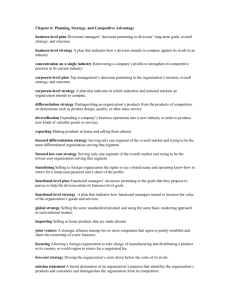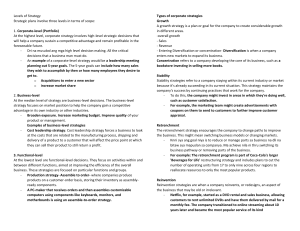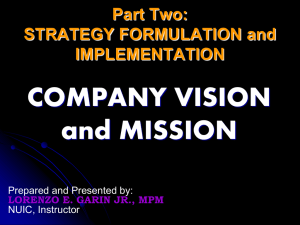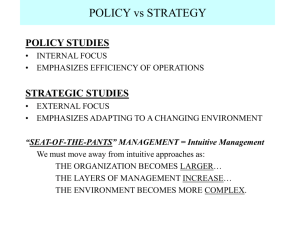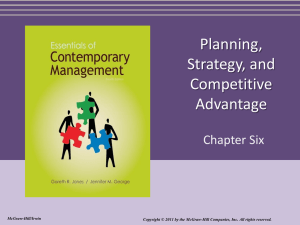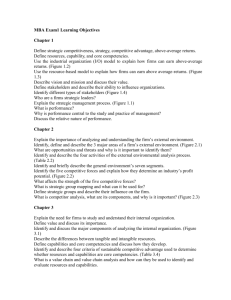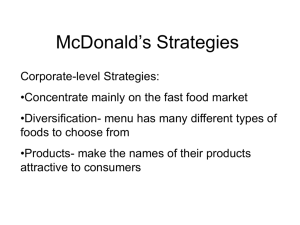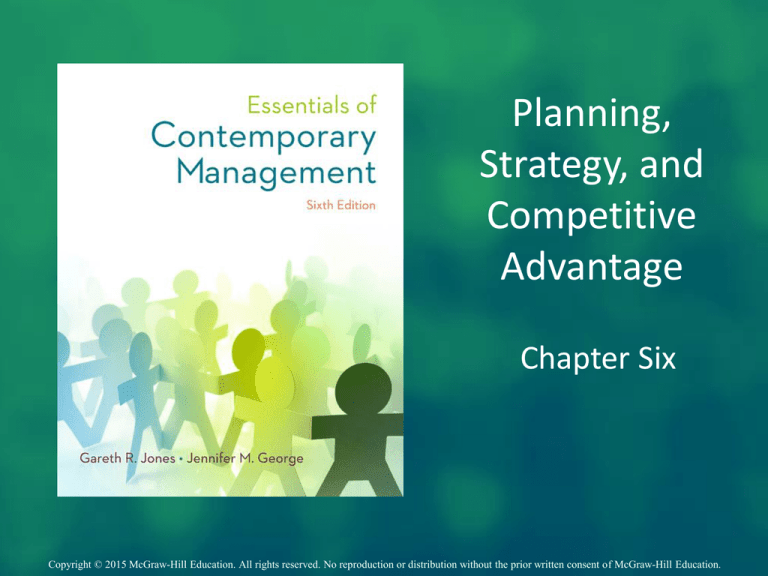
Planning,
Strategy, and
Competitive
Advantage
Chapter Six
Copyright © 2015 McGraw-Hill Education. All rights reserved. No reproduction or distribution without the prior written consent of McGraw-Hill Education.
6-1
Learning Objectives
LO6-1 Identify the three main steps of the planning process
and explain the relationship between planning and
strategy
LO6-2 Differentiate between the main types of businesslevel strategies and explain how they give an
organization a competitive advantage that may lead
to superior performance
LO6-3 Differentiate between the main types of corporatelevel strategies and explain how they are used to
strengthen a company’s business-level strategy and
competitive advantage
LO6-4 Describe the vital role managers play in
implementing strategies to achieve an organization’s
mission and goals.
6-2
Planning and Strategy
Planning
Identifying and
selecting appropriate
goals and courses of
action for an
organization
Strategy
A cluster of decisions
about what goals to
pursue, what actions
to take, and how to
use resources to
achieve goals
6-3
Planning and Strategy
Mission Statement
A broad declaration of an organization’s purpose
that identifies the organization’s products and
customers and distinguishes the organization
from its competitors
6-4
Levels and Types of Planning
Business-Level Plan
Divisional managers’ decisions pertaining to
divisions long-term goals overall strategy, and
structure
Business-Level Strategy
outlines the specific methods a division, business
unit, or organization will use to compete
effectively against its rivals in an industry
6-5
Levels and Types of Planning
Functional-Level Plan
Functional managers’ decisions pertaining to the
goals that they propose to pursue to help the
division attain its business-level goals
Functional-level strategy
A plan of action to improve the ability of each of
an organization’s functions to perform its taskspecific activities in ways that add value to an
organization’s goods and services.
6-6
Standing Plans
Policies
general guides to action.
Rules
formal written specific guides to action.
Standard operating procedures (SOP)
specify an exact series of actions to follow
6-7
Three Mission Statements
Figure 6.4
6-8
Determining the Organization’s
Mission and Goals
Strategic leadership
the ability of the CEO and top managers to convey
a compelling vision of what they want the
organization to achieve to their subordinates
6-9
Planning and Strategy Formulation
Figure 6.5
6-10
Formulating Corporate-Level Strategies
Concentration on a
Single Industry
reinvesting a
company’s profits to
strengthen its
competitive position
in its current industry
6-11
Stages in a Vertical Value Chain
Figure 6.6
6-12
Diversification
Diversification
expanding a company’s business operations into a
new industry in order to produce new kinds of
valuable goods or services
6-13
Four Ways of Expanding
Internationally
Figure 6.7
6-14
International Expansion
Exporting
making products at home and selling them
abroad
Importing
selling at home products that are made abroad
6-15

